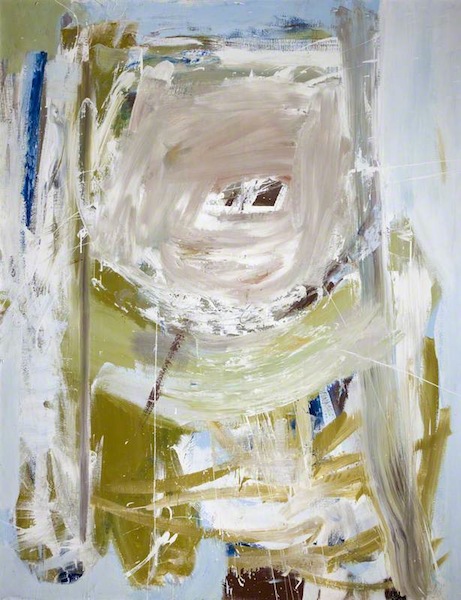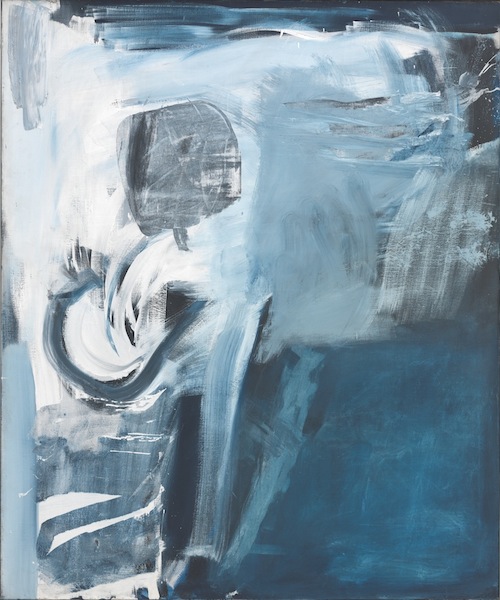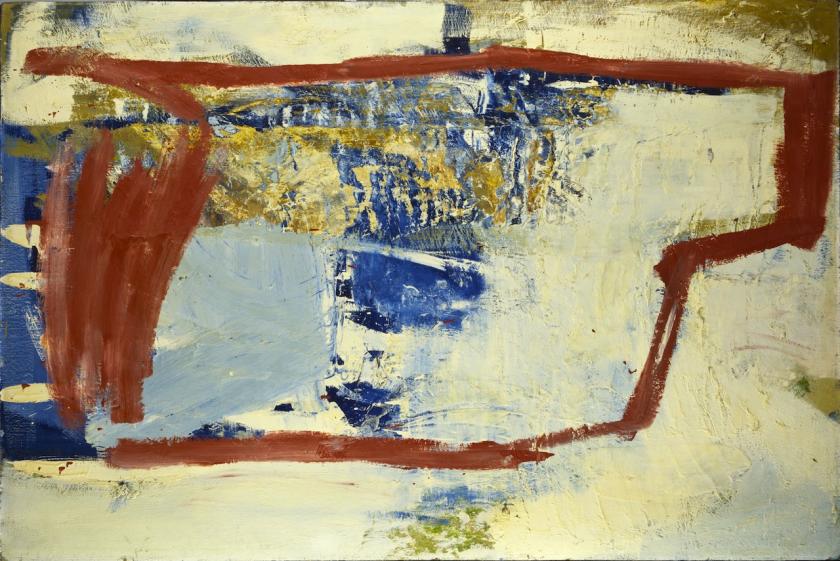Free as air, but there was a very heavy price to pay for his ecstatic exploration of the sky by the Cornwall painter Peter Lanyon, who died in 1964, aged just 46, as a result of injuries received in a gliding accident.
The Courtauld Gallery is known for its series of original, incisive, acute and intense exhibitions taking a sharply focused view of one aspect of an artist’s work. Often these provide a revelation and so it is here.
For Lanyon, who has fallen out of fashion as have several other significant figures of his generation of British artists, this is a very welcome examination of a quite extraordinary leap of artistic imagination. Because of the Courtauld’s own exemplary holdings and its art world connections, we are even introduced to the exhibition, and if you like a British sensibility, by a room full of figurative work by Sickert, Freud, Kossoff and Auerbach. Their profound urban commitment to representation, portraits and city scenes, is perhaps inadvertently a stimulating contrast to the intensity of Lanyon’s pursuit of country and coastal landscape. Lanyon himself, dedicated to landscape, thought of Turner, historically, as a kind of mentor, in extending the possibilities of expressing the emotion of landscape in visual terms.
Lanyon was close to the land and also very used to working with his hands; he had been a flight engineer throughout the war, stationed in the Middle East, North Africa and Italy. He studied art in several sporadic patches, engaged in teaching, and knew his fellow artists, several of international reputation, in St Ives as it became a thriving avant-garde artists’ colony. Surrounded by such abstractionists as Naum Gabo and Ben Nicholson, Lanyon claimed always and justly to be a painter of places. (Pictured below: Rosewall, 1960; Ulster Museum)
 Remote as he might have been geographically for much of his short life from city centres, he had spent stimulating time in New York, exhibited there and seen the work of the Abstract Expressionists. These experiences, much as he resented being called an abstract artist himself, must have liberated him in certain ways in terms of interpreting his feelings for landscape in visual terms. Indeed Mark Rothko and his family visited the Lanyons in Cornwall, and there was talk of finding a studio there for him.
Remote as he might have been geographically for much of his short life from city centres, he had spent stimulating time in New York, exhibited there and seen the work of the Abstract Expressionists. These experiences, much as he resented being called an abstract artist himself, must have liberated him in certain ways in terms of interpreting his feelings for landscape in visual terms. Indeed Mark Rothko and his family visited the Lanyons in Cornwall, and there was talk of finding a studio there for him.
Although Lanyon never considered his painting to be abstract it was much more a meditation on landscape rather than a depiction. The painter, he said, constructs out of experience. The feeling for landscape, its portrayal by Lanyon in a series of unexpected, choreographed gestures – a dance in paint – was paramount. The visual and emotional experiences that came to him through his years of gliding were an apotheosis: “I paint the weather and high places where solids and fluids meet.”
Born and brought up in West Cornwall he was intimately familiar with the Cornish coast which formed his subject matter of choice. But he was drawn upwards and onwards by the seduction of flying over the beloved landscape in a glider, and learnt to follow this dangerous and skilled pursuit.
The first gallery shows us his landscape paintings pre his own taking to the sky. Prophetic perhaps is Bird Wind, 1955, in sombre but softly luminous colours in a range of greys and blacks, an imagined encounter high in the sky with a turning bird.
High Ground, 1956, with a variety of greens inserted among more reticent colour was, we are told, described by Lanyon as “a picture of tall dry grass blown about in the wind”. The whole is an irregular patchwork, almost as though it were again prophetically an aerial view, although we can also imagine ourselves walking among rustling vegetation. What Lanyon’s landscapes do – helped by their titles – is leave plenty of room for our imaginations to roam, to match his suggestions and allusions with our responses.
Silent Coast, 1957, with its gloriously seductive blues expresses the kind of ever-changing relationship between land and sea, coast and ocean. These landscape paintings are curiously more specific, perhaps because Lanyon posited one point of view, one vantage point, before he found what he thought of as liberation, the extraordinary expanse of viewpoints as he glided over the landscape. High Wind, 1957, well indicates the turbulence that we feel when buffeted by the invisible currents of air all round us, and the dancing brushstrokes pin down into visibility just that swirling movement.
It is difficult to find or imagine other artists working in this way, when they are on the move rather than settled into a fixed physical relationship to the scenes that are their subjects. There are of course the magnificent series of cloud studies by Constable, but the artist would have looked at the moving skyscape from one point of view. The cloudscapes of Claude Rogers (another currently unfashionable artist) which were inspired by views out of aircraft are the only potential parallel.
 The gliding paintings, just over a dozen, convey exhilaration and excitement with a convincing physicality. “The air”, Lanyon wrote, “is a very definite world of activity as complex and demanding as the sea”. As he learnt to glide among thermals and uplifts and currents, to soar and float and go cross country, to rise and fall and control his movements in the air, Lanyon responded with masterly images. Thermal, 1960 (pictured above; Tate), Solo Flight, 1960 (main picture), Cross Country, 1960, Soaring Flight, 1960, and perhaps most dramatically, Long Shore, 1962 are communicably expressive of these unprecedented views. The several three-dimensional schematic sculptural constructions also on view, do not possess the striking emotional exuberance of the paintings.
The gliding paintings, just over a dozen, convey exhilaration and excitement with a convincing physicality. “The air”, Lanyon wrote, “is a very definite world of activity as complex and demanding as the sea”. As he learnt to glide among thermals and uplifts and currents, to soar and float and go cross country, to rise and fall and control his movements in the air, Lanyon responded with masterly images. Thermal, 1960 (pictured above; Tate), Solo Flight, 1960 (main picture), Cross Country, 1960, Soaring Flight, 1960, and perhaps most dramatically, Long Shore, 1962 are communicably expressive of these unprecedented views. The several three-dimensional schematic sculptural constructions also on view, do not possess the striking emotional exuberance of the paintings.
In deference to the white cube convention of showing art, so prevalent in the 1960s, Lanyon’s paintings are set against white walls. The convention does not do his paintings enough justice, as the blinding whiteness and the spotlights diminish his subtle imagination, evident on close inspection in brushstroke and colour. These are indeed paintings that soar.









![SEX MONEY RACE RELIGION [2016] by Gilbert and George. Installation shot of Gilbert & George 21ST CENTURY PICTURES Hayward Gallery](/sites/default/files/styles/thumbnail_125_x_125_/public/mastimages/Gilbert%20%26%20George_%2021ST%20CENTURY%20PICTURES.%20SEX%20MONEY%20RACE%20RELIGION%20%5B2016%5D.%20Photo_%20Mark%20Blower.%20Courtesy%20of%20the%20Gilbert%20%26%20George%20and%20the%20Hayward%20Gallery._0.jpg?itok=3oW-Y84i)





Add comment